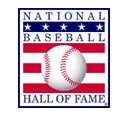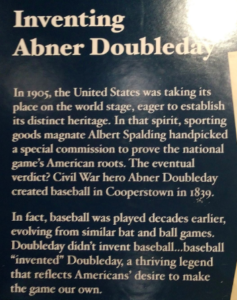Sometimes for better, often for worse, the Chicago Cubs have a very prominent place in baseball history. This is undeniable, as they are one of the sport’s biggest brands, and their imprint at the Baseball Hall of Fame in Cooperstown, New York is expectedly massive.
Let’s take a look at what Cubs fans need to see and experience when they visit the Hall of Fame. First though a little history about why the museum is located where it is.
Why is the Hall of Fame in Cooperstown of All Places?
Way back towards the beginning of the 20th century, a corporate tycoon named Spalding, yes of the ballmaker Spalding, wanted to establish the idea of baseball as an inherently and uniquely American game. (Spoiler alert: it’s actually kind of not). He then commissioned a totally b.s. “historical commission” who came up with the lie that General Abner Doubleday invented baseball in Cooperstown, New York.
Meanwhile, Doubleday himself never claimed that he invented the game, and the modern version of what we know today as baseball, with the organization, format and rules etc. was started by Alexander Cartwright in 1845 at the Knickerbocker club in Manhattan.
However, a rich powerful sporting goods salesman wanted a bucolic fantasy centered around a Civil War hero, so he created one.
Then somebody found an old-timey baseball in a tree on the Graves farm in upstate New York. Supposedly, General Abner Graves (apparently, Abner was a very popular name back then) played baseball with Doubleday in this rural town on Otsego Lake, and this artifact was deemed “historical” and “proof” of baseball’s birth.
Why Does the Lie Persist Today?
In the 1930s, a rich and powerful Wall St. financier named Stephen C. Clark called upon his connections in Major League Baseball, Ford Frick, who was then National League Commissioner. The legendary broadcaster and sportswriter, who would later go on to become MLB Commissioner, took Clark’s idea to hold an annual MLB festival and All-Star Game in the town and then conceived the baseball museum concept.
Clark and Frick are basically the two fathers of the baseball hall of fame, and as such oil painting portraits of both men reside near the entrance today.
How do you get there/what’s it like?
Cooperstown, a town of about 1,700 people is nestled on a gorgeous lake in the middle of the scenic Adirondacks. It’s a tiny village in the middle of absolutely nowhere and it’s extremely inconvenient to get to. There are three airports you can fly into- Albany, Syracuse or Binghamton, and then drive 90 minutes and change from any of those destinations.
I choose Albany, and I highly recommend it because then your drive is on Scenic Byway 20, which lives up to the hype and then some. Just be careful of all the deer at night.
Once in Cooperstown, you’ll have a visiting Colonial Williamsburg kind of experience, as you’re transported to another place that’s stuck in a long ago time.
Cooperstown Main Street is basically a place where it’s Fourth of July 1903 every single day. It’s like a real life, fully functioning version of the Museum of Science and Industry’s “Yesterday’s Main Street” exhibit…meets the set of “The Music Man.”
The shops immediately surrounding the Baseball Hall of Fame are all related to the sport, and specialize in memorabilia, cards, trinkets, apparel and much more. This is worth the trip all by itself, but let’s get to the Baseball Hall of Fame already!
https://twitter.com/PaulMBanks/status/1157789760783605760
Baseball Hall of Fame Street Level
The gist of level one is pretty much the Hall of Fame gallery. It’s really the only thing you need to see on this level (Although the one room art museum is really nice too), as it’s the collection of plaques of the diamond’s all-time most immortal figures. It’s what you think of first when you think of Cooperstown, as this is what we always see on television.
For Cubs fans, be sure to check out the plaques belonging to Ernie Banks, Billy Williams, Ryne Sandberg, Ron Santo, Fergie Jenkins, Joe Tinker, Johnny Evers, Frank Chance, Gabby Hartnett, Andre Dawson, Hack Wilson, Rabbitt Maranville, Rube Wadell and many more.
https://twitter.com/PaulMBanks/status/1157789412404715523
Go check out Greg Maddux’s plaque with the non-affiliated hat. Be sure to check out Cap Anson’s bronze as well, but first listen to our podcast in which we discuss what a horrifyingly deplorable white supremacist he was, and the irony of where his final resting place is.
Baseball Hall of Fame Level 2
This is the meat and potatoes of the Baseball Hall of Fame, and it’s the level where just everybody begins their individual self-guided tour. It takes you through the entire history of the game, starting with depictions of people playing stick and ball games as far back as Medieval Times and even ancient Egypt.
The Cubs were baseball’s very first dynasty, back in the 1900s, and that’s depicted by artifacts from Tinker-to Evers-to Chance, who all went in the Hall together in the same year. Their display case is right next to the Doubleday ball.
https://twitter.com/PaulMBanks/status/1157808075472023555
Poor Hack Wilson, he set a record for single season RBIs that will probably never be broken, yet he died very young and working as a towel boy in a Baltimore community pool. Wilson was such an extreme drunk that…well, we’re going to cover that on the next episode of the “Let’s Get Weird, Sports” podcast.
Oh, and he’s egregiously body-shamed in Cooperstown (see above).
To me though, the most interesting thing of all in the hall of fame is what passes as “the steroid wing.”* Yes, the steroid era is covered, in just one display case, which focuses on artifacts relating to PEDs.*
https://twitter.com/PaulMBanks/status/1157841113379741696
As you would expect, Sammy Sosa and Mark McGwire are the main attractions in this display. But don’t forget about Rafael Palmeiro, who came up with the Cubs. The Barry Bonds 756 home run ball, with the asterisk burned into it is here.
Oh and might I add, asterisk*.
Babe Ruth and Hank Aaron are the only individuals with entire sections devoted to their lives and achievements, and no doubt Barry Bonds will spend the rest of his days irate about that.
You’ll see a lot other smaller interesting Cubs related items along your journey here as well, including a WGN/Cubs superstation bumper sticker from the ’80s and the “NO LIGHTS” at Wrigley Field protest signs from before the ballpark got illuminated.
Baseball Hall of Fame Upper Level
A lot of people don’t make it to level three, and if they do, they don’t spend a lot of time there. That’s really unfortunate as there’s a whole lot to see in the ballparks section and the new baseball card exhibit, which includes the rarest most valuable baseball cards that you can possibly fathom.
There’s also historical artifacts from, and an artistic interpretation of Babe Ruth’s famous “called shot” at the 1932 World Series in Wrigley Field.
Did it really happen? Did the Bambino actually accurately (and arrogantly) predict exactly what he was going to do? It’s very debatable.
What’s not debatable, and take this from someone who’s been to all four major sports hall of fames, baseball’s the best of all.
Paul M. Banks runs The Sports Bank.net, which is partnered with News Now. Banks, the author of “No, I Can’t Get You Free Tickets: Lessons Learned From a Life in the Sports Media Industry,” regularly appears on WGN CLTV and co-hosts the “Let’s Get Weird, Sports” podcast on SB Nation.
You can follow Banks, a former writer for NBC Chicago.com and Chicago Tribune.com on Twitter here and his cat on Instagram at this link.







